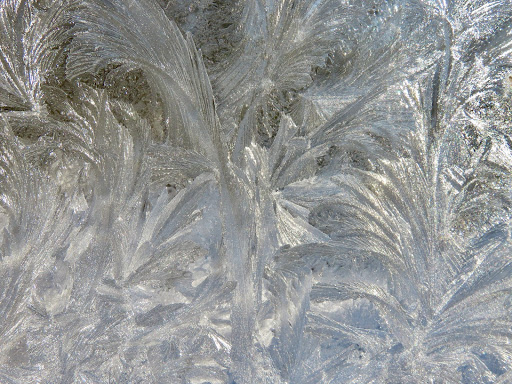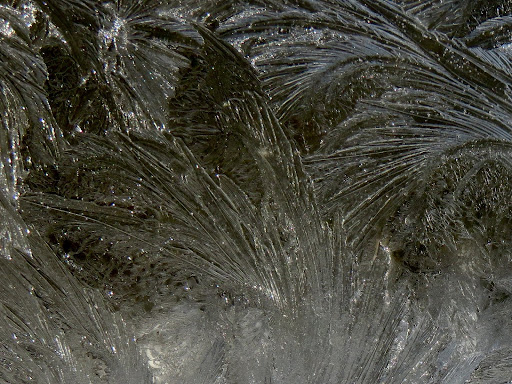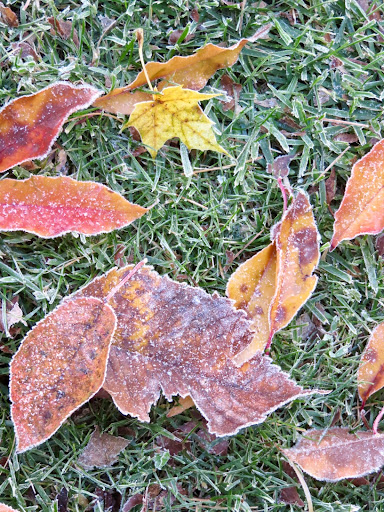This week started out cold, with single digit mornings in my neighborhood. These low temperatures, in conjunction with some other favorable conditions, created one of my favorite winter phenomena. My first view of the world on Tuesday morning was this:

Window Frost on February 15, 2022
Elegant ferns and swirls covered the bathroom window, backlit by the rising sun. Window frost is surely one of nature’s most lovely creations. First I admired the patterns, then I quickly grabbed the camera. Later that day I started to wonder about their formation.
For starters, all frost crystals require water vapor and cold temperatures. Snow expert, Kenneth Libbrecht, offers this concise explanation: “Window frost forms when a pane of glass is exposed to below-freezing temperatures on the outside and moist air on the inside.” My upstairs bath is a cool, moist room with a window that is well-suited to frost production. Built in 1852, the house has six-over-six windows – some with antique, bubbled glass – which provide a weak barrier between the room and the newer storm windows. Apparently, double-paned windows provide better insulation and fewer opportunities for frost masterpieces. Perhaps this should worry me. According to home improvement specialist, Bob Vila, “Being a responsible homeowner means letting go of some romantic ideas about nature, like the beauty of frost on your windows in the morning.” Call me irresponsible.

Closeup of Window Frost with Contrast Increased
I should clarify a couple of aspects of this phenomenon. First, the frost is forming on the inside of the window, not outdoors. Secondly, the process of “deposition” involves a direct transformation of a gas (the water vapor) to a solid (the frost crystals). There is no liquid water involved. Wikipedia’s entry on “Frost” uses the term desublimation. You may recall from high school science classes that sublimation occurs when a substance transforms from a solid to a gas. Imagine frozen laundry on a clothesline. In time, the ice vaporizes rather than melts. The formation of window frost is the opposite process.
What is the relationship between window frost and the frost we see outdoors? Once again, the process requires cold temperatures and moisture. The moisture might originate from the soil, from snow cover, or from nearby open water. The National Weather Service lists several conditions that increase the likelihood of an overnight frost including clear skies, light winds, and cool temperatures. Low-lying areas such as valleys or “frost pockets” will have lower temperatures than surrounding areas. Similarly, the temperature at ground level might be several degrees cooler than the air temp just a few feet higher.
One important factor is the relationship between surface temperature and dew point. “The dew point is the temperature to which air must be cooled to become saturated with water vapor. . . .” [Wikipedia definition] This temperature will vary depending on atmospheric pressure and humidity. Meteorologist Jeff Haby describes this relationship in “The Forecasting of Frost” at weather.gov. From my understanding, both the surface temperature and the dew point need to be below freezing. Furthermore, “ . . . frost will only form if the ground temperature matches the dew point.” So, now I’m looking at dew points when I check the weather forecast. One thing does lead to another!
As February progresses, the days grow longer and the cold spells will be offset by thaws; snow competes with mud. All the same, there is plenty of time left this year to observe the magic of a frosty morning. Many individuals and organizations keep records of first/last frost dates including The Old Farmer’s Almanac and Dave’s Garden. The National Weather Service has data going back to the 19th century. In the Brockton area, the mean last frost date over the past 20 years has been April 27. The mean first frost date is now October 19. Interestingly, today’s frost season is, on average, 15 days shorter than the mean dates for the 20th century. Perhaps we won’t have as many opportunities to see frost, afterall.
What is certain is that frost offers an ephemeral beauty: its complex and exquisite patterns melt with the morning sun. So, despite the chill, venture out some mornings to take a closer look.
